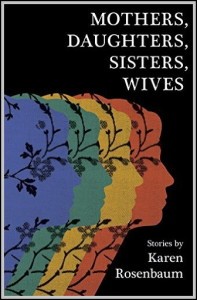Review
======
Title: Mothers, Daughters, Sisters, Wives
Author: Karen Rosenbaum
Publisher: Zarahemla Books
Genre: Fiction—short story collection
Year of Publication: 2015
Number of Pages: 199
Binding: Softcover
ISBN13: 978-0-9883233-6-0
Price: $14.95
 Reviewed by Julie J. Nichols for the Association for Mormon Letters
Reviewed by Julie J. Nichols for the Association for Mormon Letters
The current issue of Sunstone carries a short story by Karen Rosenbaum entitled “Mothers and Daughters.” It has three brief sections: “Else Pedersen Mikelsen, 12 January 1850-28 May 1920”; “Anna Maren Mikelsen Jensen, 14 Jun 1878-9 September 1950”; and “Dinah Else Jensen Daynes, 22 March 1912-1 October 2005.” These are the names and birth-and-death dates of three women living, working, and raising families in Logan, Utah. Each section takes place on the death date of the named mother, and follows the thoughts of the surviving mourning daughter. Else Pedersen Mikelsen’s daughter is Anna Maren Mikelsen Jensen, whose daughter is Dinah Else Jensen Daynes. Dinah’s surviving daughter is Maren. Through Anna, Dinah, and Maren, we come to know four generations of Mikelsen women—their toughness, their kindness, their perseverance, their love. They’re not perfect, but they’re committed to their families. There are no complaints, only a good pure grief at their passing after long and hard-wrought lives.
“Mothers and Daughters” is the third story of fourteen in this excellent collection of Rosenbaum’s stories. They have been written and published in various journals over four decades and are brought together at last in an attractive volume by Zarahemla Books, whose offerings are among the best that thoughtful Mormons can find. The fourteen stories are grouped into four divisions, each unrelated to the others. But the stories in each division follow the women in a single family, or follow one woman through several episodes. It’s a little like watching a good TV series—the reader’s understanding of and sympathy for the characters in each division grows with each story. We’re sorry to leave them behind for the next batch.
Yet each batch is singular and compelling. Certain characters are hard to forget. For example, among the Mikelsen women we also come to know Dinah’s snappish older sister Carrie. She appears in the first story, “Burial Places,” where the child Maren (Dinah’s daughter, remember) places flowers on family graves during the traditional family Memorial Day rituals some time in the fifties. And the second story, “The Price of Ties,” shows Maren and Dinah visiting Carrie at the nursing home where she spends her last days, remembering and rehashing her life and the family she and Dinah grew up in. The stakes are not high in any of these first three stories. There are no explosions, no melodramatic breaks or reunions. Instead, Rosenbaum develops before our eyes the strong quiet ties that bind families through every kind of vicissitude. I wanted more.
“Elaine” is the title of the second grouping of stories. The first, “Immersions,” presents the child Elaine, whose terror of water drives her behaviors at the lake and at the baptismal font. Yet somehow she overcomes the fear, and in “Long Divisions” and “Havesu,” she is an adult who has lost her faith and has married Rob, also a nonbeliever. They are braving a rafting trip on the Colorado on a vacation from their New York City life. “Long Divisions” is told from Elaine’s point of view, “Havesu” from Rob’s, as they navigate their feelings about family life and reconciliation of sorts with the church of their youth. The final story in the group of five is “The River Rerun,” in which they revisit all that’s happened since the first rafting trip. It comes after a sweet piece (“Paradise Paved”) which, like “Mothers and Daughters,” has three sections. In the first, Elaine is young again, though older than in “Immersions.” In the second, she and Rob are experimenting with returning to church. In the third, she cares for her elderly mother (I was looking for Dinah or Maren, but no—this is another family altogether, another setting), remembering, remembering.
As in the first half of the book, the remaining two sections present no grand crises, no shocks of recognition or revelation. But “Lauren, Charlotte” gives us two more strong and beautiful women we want to follow even further than Rosenbaum takes us. Lauren is Charlotte’s niece. Their relationship allows them a closeness that can reveal “Aunt Charlotte’s Secrets” near the end of Charlotte’s life—and also, gently, Lauren’s. In “Requiem in L Minor,” whose structure pleased me very much, Charlotte recopies the faded names and addresses of all the L’s in the old address book. Their stories are Charlotte’s stories, too—kind, human, caring. This is Lauren’s legacy, as is her relationship with her sister Nita, lovingly unfolded in “Missing Person, Sister Night,” and in “Benares,” we see her in India, wishing Nita there too as she contemplates the great differences between her home culture and this Eastern one. Lauren is lovely.
“Carma” suffers rheumatoid arthritis, and everything’s hard, but she pushes through—church, school programs, sister-in-law’s illness. In the two stories that complete *Mothers, Daughters, Sisters, Wives,* Carma embodies all that the other women in this collection represent: stoicism, intelligence, doubt, struggle, hope. The success of Rosenbaum’s exploration of narrative technique—point of view, structure, timeline—parallels the success of her characters’ development.
Fast action and high suspense there is not, but profound sympathy for the connections between and within women’s hearts there is in abundance. None of the women is an activist rallying for change in the Church or even for final resolutions in her family, but each of them observes, considers, and comes to her own honest conclusions.
We are happy to have known all of them. This is a lovely volume.
